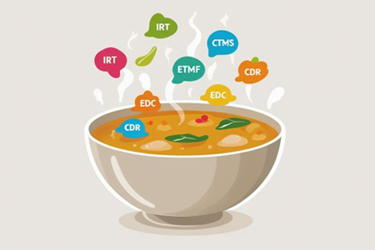Breaking Free From The Acronym Soup: Rethinking The Role Of Technology In Clinical Trials
By Ivanna Rosendal, VP and global head of digitalization, Ascendis Pharma

What does it take to start clinical trials in just days and pivot when the trial dictates it? Not our current approach. Rather than our current focus on systems supporting clinical trials, we need to build the capabilities that deliver the same functionality in many different modalities. These modalities should align with the clinical trial we want to run, not determine how we run it. This article will detail how clinical systems hinder clinical trial execution and why we should rethink how technology can support our trials.
How Clinical Applications Have Created Organizational Debt
For the past 20 years, sponsor-led clinical trials have largely been digitized with the help of specialized clinical applications. Early-stage clinical trials run by smaller biotech and cell and gene therapy companies , and much of the clinical research in academia are still conducted on paper. But for large sponsors and, increasingly, midsize companies, owning a full suite of clinical applications has become the norm.
Dedicated applications supporting clinical processes have allowed higher-quality data collection, faster processing times, and standardization across trial programs. They also allow us to understand the execution of the trials and to assess their health. The typical applications include those for randomization (IVRS/RTSM), trial operations (CTMS), trial document management (eTMF), data capture and cleaning (ePRO/EDC/CDR), and statistical programming (SCE). For the uninitiated, the suite of applications seems more like a soup of acronyms than a coherent ecosystem. Just as vegetables dissolve in soup, these acronymous applications blend as they include chunks of functionality already belonging to a different application.
To oversee a suite of applications, sponsors have established special teams that manage, improve, and validate them. Each system is a heavy investment, both in fees to vendors and in building internal competency to manage them.
In my experience implementing clinical systems over the past 15 years, the expected lifespan for a clinical system is five to eight years, but it often becomes 10. This means that we tie our technological capabilities to the advancements of a prior decade. But, even worse: The people in our organizations specialize and develop expertise in technology that is due for a replacement.
Having a set clinical application landscape, with dedicated application teams and quality documentation with a long investment horizon, has created technical and organizational debt in our companies. This debt means that when we onboard new clinical trials into our system landscapes, we inadvertently influence how the trial is set up. By using old technology and processes defined years ago, we introduce slowness and rigidity into our clinical programs — a luxury we cannot afford when patients are waiting for treatment.
I am not making a case for purchasing new technology. Many promises for optimization have been made, spanning from the clinical platform craze of the past 10 years to everything AI. None of these has delivered on the promised value creation. Looking for the technological silver bullet will keep us from achieving what we should be aiming for: the right technology that fits the trial.
I am making a case to stop focusing on the technology and start focusing on the problem it is supposed to solve. And, we must build capabilities that can deliver these solutions without creating such deep organizational grooves as our current clinical technologies have made.
Your Trial Matters More Than The Technology It Runs On
As trial design grows increasingly complex, the competition for getting regulatory approval first rises, and investment in biotech remains lower than in recent years, sponsors must initiate the trial as soon as the design is confirmed. Part of trial initiation is configuring, integrating, and validating the applications that the trial will run on. Additionally, with complex treatments, it is increasingly likely that sponsors will adjust the trial design during the trial. This means reconfiguring the applications on which the trial is running, with the implications of revalidating the setup.
For small and midsize life sciences companies, running a trial means collaborating with a network of vendors. These vendors must exchange data in a compliant way, while remaining in control of the validity of the data, even though it may happen outside of the sponsor’s application landscape. Additionally, to track trial progress and evaluate whether adaptations are needed, sponsors must analyze together internal and vendor data.

Figure 1: What Clinical Trials Need from Technology
This need for flexibility does not leave much room for legacy processes and technology. Neither does it necessarily fit neatly into the groove that our legacy systems and processes have created in our organizations. Flexibility, therefore, is necessary to get medicine to patients as quickly as possible.
This is where I argue we can build flexibility in a new way, without necessarily having to rid ourselves of the groove we already have.
Create A Flexible Trial Delivery Model By Building Capabilities
The upside of these conjoined systems and a rich vendor landscape is that the same capabilities can be delivered in many ways. However, the sponsor must understand the necessary capabilities. I suggest starting with:
- Site engagement
- Trial management
- Data collection
- Data transfer
- Data analysis
- Trial archiving
The list above is not all-encompassing. After all, a capability creates an outcome for the trial, but the means to reaching it can vary.
For each of the capabilities, sponsors can choose among the following modalities of delivery:
- Use a fully outsourced model.
- Do it manually on paper.
- Use internal applications.
- Use vendors to solve some of the needs and internal capabilities for the rest.
The sponsor company must understand the capabilities needed to deliver a trial and which delivery modality is the optimal choice for the specific trial. The best-suited modality can depend on trial timelines, the design of the trial, geographical considerations, and the competitive landscape.
To create this internal understanding of capabilities and their delivery modalities, sponsors must understand:
- Trial, technology, quality, and vendor management teams must be on the same page about what the trial program is about.
- Technology teams must be able to activate capabilities provided by partners. The company’s quality management framework must allow flexibility in the validation and documentation of the applications used. A flexible contracting model must be in place to allow for multiple framework agreements with vendor companies, and specific trial agreements can be executed swiftly.
- Sponsors must be invested in these up front so that when a new trial is created, it can be serviced by a flexible organizational model supporting the clinical program’s goals.
- CROs and technology partners must also be willing to engage with sponsor companies more flexibly, allowing them to lead and support the trial goals and not lock them into long, inflexible contracts.
Sponsors must also continuously look for partners, technology, and process developments in the clinical trial delivery space and update their capabilities accordingly.
Developing medicine for patients requires all involved parties to bridge company borders. Thankfully, the life sciences is a complex and adaptable ecosystem. If we remain flexible in how we act together, we can ensure trial execution is not gridlocked in old technology but empowered by the most relevant modality.
About The Author:
 Ivanna Rosendal is the VP and global head of digitalization at Ascendis Pharma and a behavioral economist. She has worked toward optimizing clinical trials in large and small biopharmaceutical companies for the past 15 years. Now, she focuses on leveraging technology to enhance the work of scientists, clinicians, and medical teams, ensuring they can make a significant impact on patient outcomes. Through initiatives like the podcast, "Transformations in Trials," she aims to make life sciences more accessible and foster collaboration to drive meaningful change. Reach out to Ivanna on LinkedIn.
Ivanna Rosendal is the VP and global head of digitalization at Ascendis Pharma and a behavioral economist. She has worked toward optimizing clinical trials in large and small biopharmaceutical companies for the past 15 years. Now, she focuses on leveraging technology to enhance the work of scientists, clinicians, and medical teams, ensuring they can make a significant impact on patient outcomes. Through initiatives like the podcast, "Transformations in Trials," she aims to make life sciences more accessible and foster collaboration to drive meaningful change. Reach out to Ivanna on LinkedIn.
